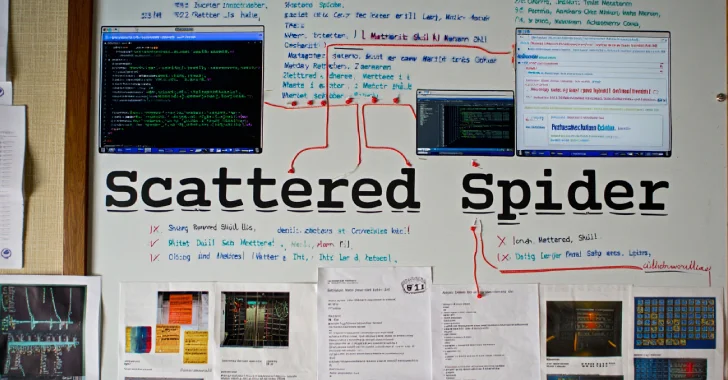
Scattered Spider Hacker Arrests Halt Attacks, But Copycat Threats Sustain Security Pressure
The Lull Before the Storm: Scattered Spider’s Retreat and the Looming Copycat Threat
Recent cybersecurity intelligence suggests a significant shift in the threat landscape. After a period of intense activity, the notorious Scattered Spider group (also known as UNC3944), responsible for sophisticated social engineering and ransomware attacks, appears to be experiencing a notable pause. This apparent lull, directly attributed to recent arrests of alleged members in the U.K., presents a critical window of opportunity for organizations. However, this respite should not breed complacency. As we’ve learned repeatedly in cybersecurity, threat actors are adaptable, and the vacuum left by one group often invites the rise of others. The ongoing risk of copycat groups seizing this moment to exploit known vulnerabilities and mimic successful tactics remains a significant concern.
Understanding Scattered Spider (UNC3944)
Scattered Spider, identified by Google Cloud’s Mandiant Consulting as UNC3944, emerged as a highly effective and persistent threat actor. This group specialized in exploiting human vulnerabilities through sophisticated social engineering techniques. Their primary method involved convincing employees to provide access to organizational systems, often bypassing traditional perimeter defenses. Once inside, they would typically escalate privileges, move laterally within networks, and deploy ransomware or exfiltrate sensitive data. Their operational sophistication and ability to adapt to defensive measures made them a significant challenge for many enterprises.
Mandiant’s recent findings indicate a direct correlation between law enforcement actions and a reduction in Scattered Spider’s activity. “Since the recent arrests tied to the alleged Scattered Spider (UNC3944) members in the U.K., Mandiant Consulting hasn’t observed any new intrusions directly attributable to this group,” states their analysis. This suggests that disrupting key members can indeed cripple a group’s immediate operational capacity.
The Copycat Conundrum: Why the Threat Persists
While the immediate threat from Scattered Spider may have diminished, the cybersecurity community faces a new, multifaceted challenge: the emergence of copycat groups. The tactics and techniques (TTPs) employed by successful groups like Scattered Spider are often documented, shared, and even commercialized within the broader cybercrime ecosystem. This means:
- Replication of TTPs: Other nascent or established threat groups can quickly adopt Scattered Spider’s proven social engineering, initial access, and lateral movement techniques.
- Exploitation of Known Vulnerabilities: The group often exploited vulnerabilities in identity and access management systems, single sign-on (SSO) platforms, and multi-factor authentication (MFA) bypasses. These vulnerabilities, even if patched, often leave a lingering attack surface if not thoroughly remediated.
- Increased Phishing and Social Engineering: Expect a continued surge in sophisticated phishing campaigns designed to mimic the success of Scattered Spider’s initial access tactics. These can target specific individuals within an organization or leverage broad, high-volume approaches.
Remediation Actions: Fortifying Defenses During the Lull
This period of reduced activity is not a time for complacency but for aggressive defense enhancement. Organizations must leverage this opportunity to bolster their security posture against not only Scattered Spider’s potential resurgence but also the more immediate threat of copycat groups. Focus on the following key areas:
- Strengthen Multi-Factor Authentication (MFA): Implement strong, phish-resistant MFA methods (e.g., FIDO2-compliant security keys) where possible. Educate users on the risks of approving unsolicited MFA prompts. Many Scattered Spider attacks relied on MFA fatigue or bypasses.
- Enhance Endpoint Detection and Response (EDR) & Extended Detection and Response (XDR): Ensure EDR/XDR solutions are properly configured and monitored. They are crucial for detecting anomalous activity, lateral movement, and the deployment of malicious tools, which are hallmarks of groups like Scattered Spider. Regularly review alerts and automate response actions.
- Robust Identity and Access Management (IAM): Implement the principle of least privilege across all user accounts and systems. Regularly audit privileged accounts. Monitor for unusual login patterns or attempts to create new administrative users.
- Security Awareness Training: Conduct frequent, relevant, and engaging security awareness training, with a strong emphasis on social engineering tactics. Educate employees on common lures, the importance of verifying requests, and how to report suspicious activity. Mock phishing exercises are highly effective.
- Patch Management: Maintain a rigorous patch management program. While Scattered Spider’s initial access often relied on social engineering, they would then exploit known vulnerabilities for privilege escalation and lateral movement. Keep all software and systems, especially those exposed to the internet, up to date.
- Network Segmentation: Implement strong network segmentation to limit lateral movement in the event of a breach. This can contain the damage and slow down attackers significantly.
- Incident Response Plan: Regularly review and test your incident response plan. Ensure roles and responsibilities are clear, communication channels are established, and recovery procedures are well-defined.
Relevant Tools for Enhanced Security Posture
Implementing a robust defense requires the right tools. Here are categories and examples of tools that can help organizations shore up their defenses against threats mimicking Scattered Spider:
| Tool Category | Purpose | Example Tools |
|---|---|---|
| Endpoint Security | Detecting and responding to threats on individual devices. | CrowdStrike Falcon, Microsoft Defender for Endpoint, SentinelOne |
| Identity & Access Management (IAM) | Managing user identities and controlling access to resources. | Okta, Microsoft Entra ID (formerly Azure AD), Ping Identity |
| Security Awareness Training | Educating employees on cybersecurity threats and best practices. | KnowBe4, Cofense, Proofpoint Security Awareness Training |
| Vulnerability Management | Identifying and managing software vulnerabilities. | Tenable Nessus, Qualys, Rapid7 InsightVM |
| Security Information and Event Management (SIEM) | Collecting, analyzing, and correlating security logs for threat detection. | Splunk, IBM QRadar, Microsoft Sentinel |
Conclusion
The arrest of individuals linked to Scattered Spider marks a significant win for law enforcement and the cybersecurity community. However, this success underscores the dynamic nature of cyber threats. Organizations must view this lull not as an end to the threat, but as a critical window to accelerate their defenses against the inevitable rise of sophisticated copycat campaigns. Focusing on robust MFA, comprehensive endpoint security, vigilant identity management, and continuous security awareness training will be paramount in transforming this temporary respite into a long-term advantage against evolving cyber adversaries.





